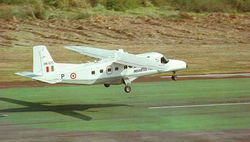|
Origin: Germany Type: Light Transport Aircraft. Accommodation: Two pilots. Weights: Empty – 2990 kg (6592 lbs.) Engine: Two Garrett TPE331-5-252D turboprops, each producing 533 shp Speed: Max. cruising speed – 231 knots (266 mph; 428 km/h) at 3050 meters (10,000 feet). Service Ceiling: 8535 meters (28,000 ft.) Range: Maximum – 1081 miles (1740 km) with 15 passengers. Capacity: 19 passengers or 2057 kg freight. Avionics: Search Radar Armament: None. Self Defence: None. More: Do-228 on Wikipedia |
Number Procured: 30+
Variants: Dornier 228-101
Units Equipped: 2+
………………….. 41 Squadron “Otters”
………………….. 59 Squadron “Hornbills”
………………….. Air Force Station Yelahanka
Brief History: The Do-228 was bought in to fill in a Light Transport Aircraft requirement within the armed forces. For the IAF, the LTA was to replace existing DHC-3 Otter and the DH Devon aircraft which were used for communication and liason flights.
Since there was demand for a similar aircraft across the Navy, Coast Guard as well as the Civilian Sector, Hindustan Aeronautics Limited (HAL) undertook a contract with Dornier for the license manufacture of the Dornier 228. Sanction was received in 1983 and production commenced in 1985-86.
The IAF initially raised a requirement for 57 aircraft. Later on, this was revised down to 43 aircraft. The first Dorniers were delivered to the IAF in late 1987 and the these were inducted formally in April 1988. The aircraft soon replaced all the Otters in No.41 and No.59 LAS Squadrons. Both these squadrons use their aircraft for laison and communication duties. With the complete phasing out of the Otters, the squadrons discarded their role of forward area supply tasks.
Additionally over a dozen Dorniers were delivered to then Transport Training Wing at Yelahanka (now AFS Yelahanka). The aircraft are used as transport trainers for trainee pilots who arrive after their trifurication at AFA Dundigal.
Over the years, HAL had produced 83 aircraft at its Kanpur facilities. It is still producing the aircraft at a rate of four to six aircraft per year. As of 2006, 61% of the aircraft’s contingent has been indigenised.
Related Links:
» Saving Grace (Vayu Aerospace)
» HAL Transport Aircraft Division, Kanpur
Serials:
